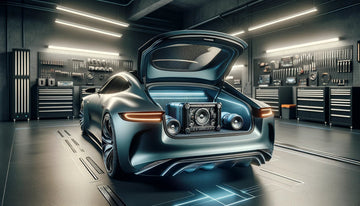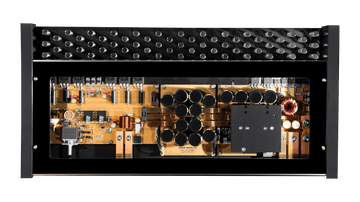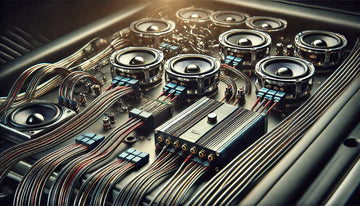Choosing a suitable car amplifier and subwoofer can make a massive difference in the sound quality of your car audio system. Whether you're a music enthusiast or enjoy listening to your favorite tunes while on the road, investing in the right equipment will enhance your listening experience. This blog will guide you through How to Choose a Car Amplifier and Subwoofer for your vehicle. We will discuss the role of amplifiers and subwoofers, essential factors to consider, the installation process, troubleshooting common issues, and how to maintain your car audio system. By the end of this article, you'll be well-equipped to make informed decisions and create the car audio system of your dreams. Adding the right amplifier and subwoofer to your car stereo system can make a massive difference in the sound quality, so choosing the right ones for your vehicle is essential.
Understanding Car Amplifiers and Subwoofers

Car amplifiers and subwoofers are essential components of any car audio system. Amplifiers increase the power of the audio signal, improving the overall sound quality, while subwoofers reproduce the low-frequency audio, adding depth and richness to the sound. Amplifiers ensure the speakers receive enough power to produce clear and crisp sound, while subwoofers deliver the deep bass that standard car speakers cannot reproduce. Together, they contribute to the overall audio quality, making the listening experience more immersive and enjoyable.
The Role of Amplifiers in Car Audio Systems
Amplifiers play a crucial role in-car audio systems. They provide the power to drive the speakers and enhance the listening experience. Without an amplifier, the sound produced by your car stereo system may lack clarity, volume, and overall quality. Amplifiers increase the power of the audio signal, allowing the speakers to accurately reproduce the sound and deliver it to your ears with precision, making a huge difference in sound quality.
When choosing a car amplifier, it's essential to consider the power rating. An amplifier's power rating indicates how much power it can deliver to the speakers. It is measured in watts and typically consists of two values: RMS wattage, which represents the average power the amplifier can deliver continuously, and peak power, which represents the maximum amount of power the amplifier can handle for short periods.
For the best sound quality, matching the amplifier's power rating to your speakers' power requirements is essential. If the amplifier has too little power, it may be unable to drive the front speakers effectively, resulting in distortion or a weak sound. On the other hand, if the amplifier has too much power, it may overpower the front speakers and potentially damage them. Finding the right balance is critical to achieving optimal sound quality in your car audio system.
The Importance of Subwoofers for Quality Sound
Subwoofers are crucial in enhancing your car audio system in delivering an immersive listening experience. By reproducing low-frequency audio, subwoofers add depth and richness to the sound, creating a balanced and impactful audio environment in your car. Standard car speakers cannot produce the deep bass that subwoofers deliver, making them essential for achieving high-quality sound. The contribution of subwoofers to the overall audio quality is undeniable, significantly enhancing the listening experience and immersing you in the music. Therefore, adding a subwoofer to your car audio system is crucial to improving sound quality and enjoying a more fulfilling audio experience.
How much power do I need in an amplifier for my subwoofer?
The power requirement for a subwoofer amplifier depends on the subwoofer's power handling and your desired listening experience. Generally, the amplifier's power output should match or slightly exceed the subwoofer's RMS power handling to ensure optimal performance and avoid damaging the subwoofer.
Factors to Consider When Choosing a Car Amplifier
When selecting a car amplifier, it's essential to consider the power requirements of your sound system. Understanding the number of channels needed for optimal performance and ensuring compatibility with your existing car audio system are crucial factors to remember. Additionally, assessing the size and type of the subwoofer that suits your needs, along with the power handling capabilities of different options, is vital. Matching your subwoofer with your amplifier, such as a 5 channel amplifier, and evaluating the necessary hardware for installation will contribute to making a more informed shopping decision. Lastly, considering the coil type and configurations and the size of your vehicle will help guarantee the best fit for your mono amp.
Number of Channels Needed for Optimal Performance
When setting up a car audio system, determining the required number of channels hinges on the number of speakers in your vehicle. Ensuring that the amplifier channels align with the number of door speakers is essential for optimal sound distribution and an enhanced sound system. A suitable amplifier with the correct channels is crucial for achieving the best sound experience. Understanding the significance of the number of channels needed for coaxial speakers directly impacts the overall performance of the sound system. By paying attention to this aspect, you can ensure that your car audio system delivers the quality of sound you desire.
Compatibility with Your Existing Car Audio System
Selecting an amplifier that seamlessly integrates with your current car audio system is crucial for optimal performance. Ensuring compatibility with your head unit and speakers is essential, as it guarantees seamless integration and performance. The amplifier's compatibility with your car's audio system, including preamp outputs, is critical in making the right choice. Choosing an amplifier that works well with your existing setup is imperative to avoid any compatibility issues and ensure a smooth audio experience. Selecting an amplifier that integrates seamlessly with your current car audio system can enhance the overall sound quality without technical limitations or disruptions.
Selecting the Right Subwoofer for Your Car

When choosing a subwoofer for your car audio system, consider the size and type that best suits your needs. Assess the power handling capabilities of different subwoofers, ensuring they match your amplifier's power requirements. Also, pay attention to the compatibility between your selected subwoofer and amplifier to achieve optimal performance. Making an informed decision to enhance the sound quality of your car's audio system is essential.
Size and Type of Subwoofer
The size and type of subwoofer you choose can significantly affect the quality of sound produced by your car audio system. It is essential to consider the space in your car and the type of music you enjoy to determine what subwoofer size and type will best suit your needs. For instance, a larger subwoofer may be necessary to achieve the desired sound if you prefer bass-heavy music genres like hip-hop or electronic dance. On the other hand, if you listen to more acoustic or classical music, a smaller subwoofer may be sufficient. Selecting the perfect subwoofer can enhance your audio experience and make your car rides more enjoyable.
Power Handling Capabilities of Different Subwoofers
Selecting a subwoofer for your car's audio system can be daunting, but understanding its power-handling capabilities is crucial. This feature directly impacts the subwoofer's ability to handle power output, ultimately affecting its performance. Choosing a subwoofer with the correct power handling capabilities is paramount to achieve top-notch sound quality.
Different car subwoofers have different power-handling capabilities that directly affect overall sound quality. Therefore, choosing a subwoofer that matches your specific needs is essential. By considering the power handling capabilities of a subwoofer, you can make an informed decision that best aligns with your car's audio setup requirements.
It is also important to note that power handling capability relates to two critical factors: RMS and peak power ratings. RMS (root mean square) rating refers to the continuous power a subwoofer can handle without getting damaged or overheated. On the other hand, peak power rating indicates the maximum instantaneous power a subwoofer can handle for brief periods.
Understanding these two ratings will help you select a subwoofer to deliver high-quality sound without distortion or damage, even when listening at high volumes. So, before making your final decision, consider all aspects of your car's audio setup and choose the right subwoofer with adequate power-handling capabilities that match your specific needs.
Matching Your Subwoofer with Your Amplifier
Matching your subwoofer with your amplifier is crucial for achieving optimal sound quality. It is essential to understand the power ratings of both components to ensure compatibility in impedance and prevent sound distortion issues, especially when dealing with a large number of subs. Another critical factor to consider is the subwoofer's frequency response, which should align seamlessly with the capabilities of your amplifier. Additionally, you need to consider the number of channels on your amplifier to power all necessary speakers and subs effectively.
It is also important to ensure that the RMS wattage of your car amplifier provides sufficient power to drive the subwoofer without overpowering it. Overpowering can lead to distortion and even damage to your equipment. By carefully considering these factors, you can achieve a harmonious and high-quality audio experience in your car.
Furthermore, it's worth noting that different brands and models may have different specifications for their subwoofers and amplifiers. Therefore, consulting with an expert or doing thorough research before purchasing is always advisable. A good understanding of these technical aspects will help you make informed choices and guarantee a great audio experience in your environment.
Installation Process for Amplifiers and Subwoofers
The installation process for amplifiers and subwoofers requires careful attention to detail and precision. First, gather all the necessary items, including the necessary hardware for installation. Next, prepare for installation by ensuring the size of your vehicle can accommodate the new additions. When installing the amplifier, consider your sound system's power requirements and ensure it has enough juice to power the subwoofer and other speakers in your car. Similarly, when setting up the subwoofer, match it with your amplifier to ensure compatibility and the best possible sound quality. Finally, follow a step-by-step guide for installing your amplifier and setting up your subwoofer, making adjustments to create the optimal sound environment within your car.
Preparing for Installation: Tools and Safety Measures
Prioritizing safety is paramount; start by disconnecting the vehicle's battery before beginning the installation process. Use appropriate tools, including wire strippers and crimping tools, to ensure secure and reliable connections. It's essential to familiarize yourself with the vehicle's wiring diagram to pinpoint the optimal amplifier and subwoofer installation locations. Remember to employ safety measures, such as wearing protective eyewear when handling power tools and electrical components. Organize your tools and materials beforehand to streamline the installation process and minimize potential setbacks. This approach will ensure a smooth and efficient installation while maintaining a safe working environment.
Step-by-Step Guide to Installing Your Amplifier
Installing your car amplifier requires precision and attention to detail. Start following the manufacturer's instructions to mount the amplifier within your vehicle's designated location. When connecting the amplifier to the power source, adhere to the recommended power wire size and fuse rating for optimal performance and safety. Calibration of the amplifier settings, including gain and crossover frequency, is crucial to tailor the audio output to your specific setup. Additionally, securely fasten the ground wire of the amplifier to a clean, bare metal surface within the vehicle to ensure adequate grounding. Finally, insulating all electrical connections with high-quality materials, including speaker wire, is essential to prevent short circuits and potential electrical hazards. You can carefully execute each step to ensure a successful and safe car amplifier installation.
Setting Up Your Subwoofer
To optimize your subwoofer's sound, position it strategically within your vehicle for enhanced bass response and overall sound quality. Fine-tune the amplifier's phase and low-pass filter settings to seamlessly integrate the subwoofer into your car audio system. Adjust the subwoofer's volume and crossover frequency to achieve a balanced, immersive listening experience. Use sound-deadening materials to minimize vibrations and resonance, thus optimizing the subwoofer's performance. Lastly, perform a thorough sound check to ensure the subwoofer complements your vehicle's audio system without overpowering other speakers. This approach will help you create a rich and balanced sound environment while enjoying your favorite music on the go.
Common Issues with Amplifiers and Subwoofers

When troubleshooting common issues with amplifiers and subwoofers, addressing power and performance problems, sound distortion issues, and compatibility conflicts between the amp and sub is essential. Overcoming power and performance problems involves ensuring the amplifier has enough juice to power the subwoofer and speakers. Dealing with sound distortion may require checking the coil type, configurations, and necessary hardware for optimum sound quality. Resolving compatibility issues between the amplifier and subwoofer includes matching the peak ratings and ensuring the right speakers are used for the best sound quality. You can ensure the best sound quality in your car's audio system by troubleshooting the biggest mistakes people make with precision and care.
Overcoming Power and Performance Issues
When setting up your car audio system, ensuring the amplifier receives enough power for peak performance is crucial. Upgrading the vehicle's electrical system, including the alternator and battery, may be necessary to meet the amplifier's power requirements. Consider implementing sound-deadening materials and proper installation techniques to minimize potential power and performance issues.
Inspecting the amplifier's cooling system and ensuring adequate ventilation to prevent overheating and maintain optimum performance is also essential. Optimizing the amplifier's power settings to match the subwoofer's RMS rating can help mitigate power and performance concerns, leading to a more satisfying audio experience. You can optimize your car audio system for exceptional sound quality and reliability by addressing these power and performance considerations.
Dealing with Sound Distortion Problems
Sound distortion is a common issue in car audio systems that can significantly reduce the quality of your listening experience. However, there are several steps you can take to address this problem and achieve a balanced audio output. Firstly, it is crucial to confirm the load impedance of the subwoofer and amplifier, as this affects overall sound quality. Adjusting the gain and crossover settings of the amplifier can help minimize sound distortion.
In addition, utilizing sound-deadening materials in your car can reduce vibrations and unwanted resonance, leading to a smoother audio experience. Identifying potential sources of interference like ground loops is also essential in mitigating sound distortion within your car's audio system. Lastly, verifying the quality of the audio signal and connections to the amplifier is paramount in addressing any potential sources of sound distortion.
By following these steps, you can effectively tackle sound distortion problems and ensure an optimal listening experience while driving. It should be noted that if these adjustments do not resolve the issue, it may be necessary to seek professional assistance from an experienced car audio technician.
Compatibility Issues Between Amplifier and Subwoofer
When setting up your car audio system, ensuring the compatibility of the amplifier and subwoofer is crucial to avoid potential audio system problems. You can address these concerns by selecting the right amplifier type that matches the subwoofer's power requirements. In some cases, impedance bridging or matching techniques can align the amplifier and subwoofer for optimal audio performance.
It is also essential to evaluate the amplifier's power rating and the subwoofer's power handling capacity to resolve compatibility issues successfully. It would help if you also determined the appropriate coil configurations for your subs. Additionally, confirming the amplifier's frequency response and crossover settings is vital to ensure compatibility with the subwoofer's capabilities, resulting in a harmonious and high-quality sound experience in your vehicle. You can achieve an exceptional audio experience while driving by paying attention to these details.
Maintaining Your Car Amplifier and Subwoofer
Regular maintenance and cleaning of your car amplifier and subwoofer are essential for optimal performance. Taking care of the internal components and ensuring that all connections are secure will extend the lifespan of your audio system. Regularly check the power and ground connections, clean the amplifier vents to prevent overheating, and inspect the subwoofer cone for any damage or debris.
Additionally, following the manufacturer's maintenance and voltage requirements guidelines will help preserve the sound quality produced by your car's audio system. By maintaining your car amplifier and subwoofer, you can enjoy an enhanced audio experience while driving, with clarity and depth in the music that fills your vehicle.
Regular Cleaning and Maintenance Tips
To keep your car amplifier and subwoofer in top condition, it's essential first to determine your vehicle's power and size requirements. Consider the type of music you listen to and select a subwoofer with the appropriate frequency response for the best audio experience. When choosing an amplifier, look for a high signal-to-noise ratio to minimize distortion and ensure a clear sound output.
Additionally, opt for a subwoofer with a sturdy and durable design to guarantee longevity and reliable performance. Finally, regularly clean and maintain your amplifier and subwoofer to preserve their optimal functionality, ensuring you enjoy high-quality sound in your car.
Longevity of Your Car Audio System
To ensure the longevity of your car audio system, it's crucial to match your power needs with the amplifier's power output. Additionally, selecting a subwoofer with a low-frequency response and impedance that aligns with your amplifier is essential for optimal performance. When choosing a subwoofer, consider its size, design, and enclosure to achieve the best sound quality and efficient use of space within your vehicle. Look for features like bass boost, crossover, and remote control for convenience and customization options. Proper installation and setup of your amplifier and subwoofer are also vital to avoid damage to your car's electrical system and ensure long-term functionality. By paying attention to these factors and ensuring your amplifier can provide a lot of power, you can extend the life of your car audio system and enjoy high-quality sound for years to come.
When to Seek Professional Help
Installing an amplifier and subwoofer in your car can be a daunting task, especially if you are not familiar with wiring or electrical systems. Seeking professional assistance is highly recommended to avoid any damage to your car or audio equipment. Before purchasing an amplifier and subwoofer, it is essential to understand your car's electrical system capabilities. You should also consider the size and type of the subwoofer and the number of channels on the amplifier for optimal sound quality.
Matching the amplifier and subwoofer correctly is crucial as it ensures seamless integration that enhances overall audio performance. Professional installation can help navigate the intricacies of wiring and installation while safeguarding your investment in-car audio equipment. Additionally, seeking expert advice can provide valuable insights into selecting compatible components, placement, acoustics, and tuning for a superior audio experience.
Making the Most of Your Car Audio Experience

To maximize your car audio experience, assess your desired sound quality and power needs before selecting a car amplifier and subwoofer. Consider the size and type of your vehicle to ensure compatibility with the chosen equipment. Look for reputable brands that produce high-quality car audio gear, such as JL Audio, to guarantee an optimal listening experience with both top and bottom tier products. Additionally, consider the installation requirements and decide whether you are comfortable handling the setup yourself or if professional assistance is necessary. Finally, budget for supplementary components such as wiring, enclosures, and speakers to fully enhance your car audio system and achieve the best possible sound quality with top- and bottom-tier products.
Conclusion
To summarize, choosing a suitable car amplifier and subwoofer is crucial for a high-quality audio experience in your vehicle. Amplifiers enhance sound performance and provide the necessary power for your car audio system, while subwoofers add depth and bass to your music. When selecting an amplifier, consider power requirements, the number of channels needed, and compatibility with your existing system. For subwoofers, consider size, type, and power handling capabilities. Proper installation and maintenance are crucial to ensuring optimal performance and longevity. Upgrading your amplifier and subwoofer can significantly enhance your daily commute, making it a more enjoyable and immersive experience. So, choose wisely, install correctly, maintain regularly, and elevate your car audio experience to new heights.





